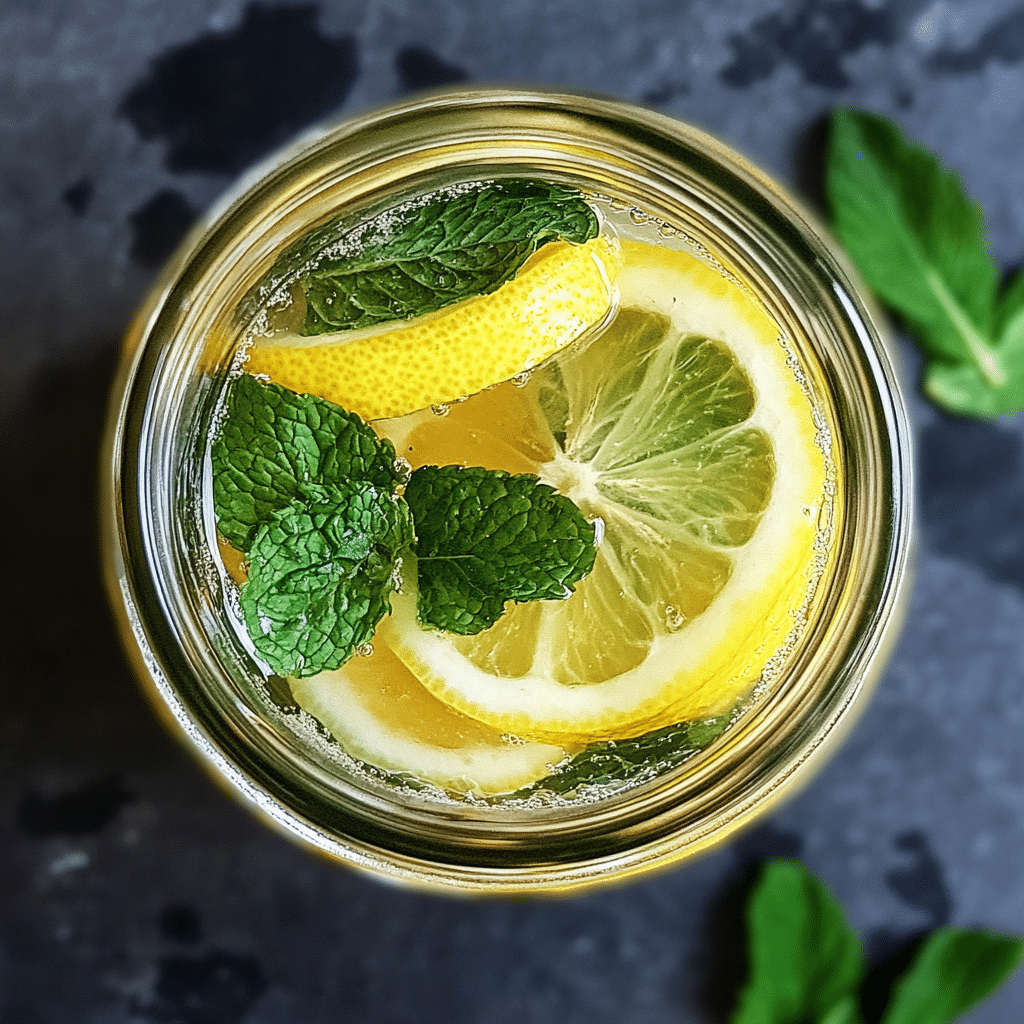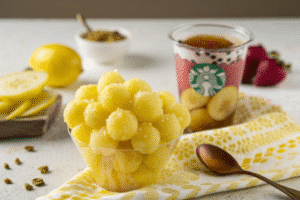Lemon balm, with its refreshing citrus-mint aroma and calming effects, is a garden favorite for herbal tea lovers. But what if you want to enjoy its flavor year-round? Drying lemon balm leaves for tea is the best way to preserve their essential oils, aroma, and medicinal benefits. In this article, you’ll learn how to properly harvest, dry, store, and brew lemon balm for tea. Whether you prefer air drying, dehydrating, or using your oven, we’ve got you covered.
Learn more about lemon balm’s benefits in herbal remedies: Lemon Balm for Weight Loss
Table of Contents
ToggleWhy Drying Lemon Balm Leaves For Tea?
Benefits of Using Dried Lemon Balm leaves in Tea
Drying lemon balm leaves for tea helps preserve its powerful compounds like rosmarinic acid and essential oils, which are known for their calming and digestive properties. When dried correctly, the leaves maintain their soothing flavor and can be stored for months, making them ideal for year-round tea brewing.
Key benefits include:
- Longer shelf life compared to fresh leaves
- Potency preserved when dried properly
- Convenient for fast, daily tea brewing
- Retains aroma for herbal tea infusions and blends
Dried lemon balm can also be mixed with other herbs like chamomile or mint to create custom calming teas.
Dried vs. Fresh Lemon Balm: Which is Better for Herbal Tea?
Fresh lemon balm has a vibrant, slightly tangy taste with a mellow mint undertone. However, it wilts quickly and loses potency fast. Dried lemon balm, on the other hand:
- Holds flavor better when steeped in hot water
- Is easier to store and use throughout the year
- Can be measured consistently for recipe use
While fresh is great for immediate use, dried lemon balm wins when it comes to convenience and longevity.
Print
Drying Lemon Balm Leaves for Tea: The Complete Guide for Beginners
5 Stars 4 Stars 3 Stars 2 Stars 1 Star
No reviews
Learn how to harvest, dry, and store lemon balm leaves to make flavorful herbal tea year-round.
- Total Time: 5–10 days (air dry) or 1–6 hours (dehydrator/oven)
- Yield: Varies based on harvest
Ingredients
Fresh lemon balm leaves (just before flowering stage)
Cool running water (for rinsing)
Kitchen towel or paper towels (for drying)
String or rubber bands (for bundling)
Optional: paper bags with holes (for air drying)
Optional: dehydrator or oven
Glass jars or airtight containers for storage
Instructions
1. Harvest lemon balm in the morning before it flowers for best aroma and potency.
2. Gently rinse the leaves under cool running water and pat dry with a towel.
3. Let the leaves air dry on a clean surface for 30–60 minutes until moisture is gone.
4. Trim stems above leaf nodes and bundle 5–10 stems together with twine or rubber bands.
5. Choose a drying method: hang bundles in a dry room, use a dehydrator at 95°F–115°F, or bake in an oven at the lowest setting.
6. For air drying, hang upside down in a cool, dark place for 5–10 days.
7. For dehydrators, dry for 4–6 hours, checking periodically.
8. For ovens, dry for 1–2 hours with the door slightly open; check every 15 minutes.
9. When leaves crumble easily and release strong lemon scent, they are done.
10. Store dried leaves in airtight glass jars, labeled and dated, in a cool, dark location.
Notes
Avoid drying in direct sunlight as it degrades essential oils.
Use dried lemon balm within 6–12 months for best flavor and potency.
Mix dried lemon balm with chamomile or mint for soothing tea blends.
Always check for mold or musty scent before using stored herbs.
Crush dried leaves only when ready to brew to preserve aroma.
- Author: Jessica Lupone!
- Prep Time: 10 minutes
- Cook Time: 0 minutes
- Category: Herbal
- Method: Drying
- Cuisine: Herbalism
- Diet: Vegan
Nutrition
- Serving Size: 1 cup brewed tea
- Calories: 0
- Sugar: 0g
- Sodium: 0mg
- Fat: 0g
- Saturated Fat: 0g
- Unsaturated Fat: 0g
- Trans Fat: 0g
- Carbohydrates: 0g
- Fiber: 0g
- Protein: 0g
- Cholesterol: 0mg
Best Time to Harvest Lemon Balm
How to Know When Lemon Balm Is Ready to Be Harvested
To get the most flavor and aroma from your lemon balm tea, timing is everything. The best time to harvest lemon balm is just before it starts to flower. At this stage, the leaves are packed with essential oils, giving you the most intense lemony flavor.
Here’s how to tell it’s harvest-ready:
- The plant is lush and full with bright green leaves
- You detect a strong lemony aroma when rubbing the leaves
- No flower buds have fully opened yet (flowering can dull flavor)
Harvesting in the morning, after the dew has dried but before the sun gets too hot, helps preserve the volatile oils that give lemon balm its soothing effects.
Ideal Weather and Season for Picking Lemon Balm Leaves
Lemon balm thrives in spring and early summer, making late May to early July the best harvest window in most regions of the U.S. But it’s not just the season—weather matters too.
Best conditions for harvesting:
- Dry, sunny mornings
- No rain in the forecast for at least a day or two
- Moderate temperatures (60°F–80°F)
Avoid picking after rainfall or during humid weather, as this can encourage mold during the drying process. When the leaves are dry and firm but still supple, they’re in their prime.
Check out this natural DIY fat-burning drink: Natural Zepbound Recipe
Preparing Lemon Balm for Drying
How to Wash and Handle Fresh Lemon Balm Properly
Before drying, you need to clean your lemon balm leaves carefully to remove dirt, insects, or pesticides—especially if they’re homegrown. But gentle handling is key because lemon balm is a delicate herb.
Here’s how to clean lemon balm for drying:
- Rinse gently under cool running water. Avoid soaking.
- Pat dry using a clean kitchen towel or paper towels.
- Let air dry for 30–60 minutes on a clean surface like a dish rack or baking sheet.
Avoid rough scrubbing, which can damage the essential oil glands on the leaves and reduce flavor. Make sure the leaves are completely dry before the next step to prevent mold.
Trimming, Bundling, and Getting Ready for the Drying Process
Once your lemon balm is clean and dry, it’s time to prep it for your chosen drying method (air, dehydrator, or oven).
Steps to prepare lemon balm:
- Trim the stems: Cut just above a leaf node using clean scissors or pruning shears.
- Bundle stems: Group 5–10 stems together and tie with kitchen twine or a rubber band.
- Label bundles (optional): If drying multiple herbs, add tags for easy identification.
At this point, your lemon balm is ready to dry. Whether you hang it upside down, use a dehydrator, or oven-dry it, preparation sets the foundation for high-quality dried herbs.
How to Air Dry Lemon Balm Leaves
Step-by-Step Guide to Air Drying Indoors
Air drying lemon balm leaves for tea is one of the simplest and most effective methods, especially if you want to preserve its natural aroma and flavor without using appliances. It requires no electricity and just a little patience.
Here’s how to air dry lemon balm indoors:
- Choose a clean, dry room with good airflow and low humidity—avoid the kitchen or bathroom.
- Hang your bundles upside down on a drying rack, hook, or hanger.
- Keep them out of direct sunlight to preserve color and oils.
- Allow 5 to 10 days for full drying, depending on room temperature and humidity.
To test for dryness, crush a leaf gently between your fingers. It should crumble easily and emit a strong, lemony scent. If the leaves feel leathery or bend, they need more time.
💡 Pro tip: Use a paper bag with holes poked in it to cover your bundle. This helps protect from dust while allowing airflow.
Pros and Cons of Air Drying Lemon Balm Leaves for tea
| Pros | Cons |
|---|---|
| No special equipment required | Takes longer (up to 2 weeks) |
| Preserves flavor and oils well | Risk of mold if room is too humid |
| Free and eco-friendly | Requires a suitable drying space |
Air drying is especially ideal for small harvests and those wanting a more hands-off, traditional approach.
Looking for inspiration? Try this article on Lemon Balm for Weight Loss to explore its full benefits.
Using a Dehydrator to Dry Lemon Balm
How to Use a Dehydrator for Consistent Drying
If you want faster, more consistent results when drying lemon balm leaves for tea, using a dehydrator is a great option. It preserves the herb’s flavor and potency while minimizing the risk of mold or overdrying.
Follow these simple steps:
- Set your dehydrator to a low herb-drying temperature—ideally between 95°F and 115°F.
- Spread the lemon balm leaves (or stem-cuttings with leaves) in a single layer on each tray.
- Avoid overlapping the leaves to allow air to circulate evenly.
- Dry for 4 to 6 hours, checking periodically. Time may vary depending on your unit and humidity levels.
You’ll know the lemon balm is ready when the leaves are crisp and crumble easily between your fingers.
Best Temperature and Time Settings for Preserving Aroma
Lemon balm’s volatile oils—what give it its scent and medicinal benefits—are sensitive to heat. Using too much heat can destroy the delicate compounds. Stick to these drying parameters:
| Setting | Details |
|---|---|
| Temperature | 95°F to 115°F (35°C–46°C) |
| Average Dry Time | 4 to 6 hours |
| Test for Dryness | Crumbles easily, lemon scent |
Don’t rush the process with high temperatures; slow and low drying ensures you retain more flavor and therapeutic value.
Discover great ideas like lemon balm-infused teas and blends in our Natural Zepbound Recipe.
Oven-Drying Lemon Balm Leaves For Tea at Home
How to Dry Lemon Balm in the Oven Without Burning It
If you don’t have a dehydrator or the time for air drying, your kitchen oven can do the trick. But be careful—high temperatures can ruin lemon balm’s delicate oils and flavors.
Here’s how to oven-dry lemon balm properly:
- Preheat your oven to the lowest setting—preferably around 170°F (77°C) or lower.
- Line a baking sheet with parchment paper.
- Spread the leaves (removed from stems) in a single layer to prevent steaming.
- Leave the oven door slightly open to allow moisture to escape.
- Bake for 1 to 2 hours, flipping once halfway through.
Check the leaves every 15 minutes. If they start to brown, they’re overheating. The goal is for them to be dry but still green, with no burnt spots.
How to Store Oven-Dried Lemon Balm for Long-Term Use
Once your lemon balm is fully dried, you’ll want to lock in the freshness and keep moisture out.
Here’s how to store it:
- Use airtight containers like glass jars with tight lids.
- Label and date the jars—lemon balm is best used within 6 to 12 months.
- Store in a cool, dark place, such as a pantry or cupboard away from sunlight.
- Avoid plastic bags unless vacuum sealed.
For maximum freshness, consider using a desiccant packet or a food-safe moisture absorber inside the jar.
💡 Bonus tip: Crumble the dried leaves only when you’re ready to brew tea to preserve their full flavor and aroma.

Storing Dried Lemon Balm Correctly
Best Storage Containers and Locations
Once your lemon balm is fully dried, your next step is to store it in a way that maintains its flavor, aroma, and medicinal properties for months.
Top choices for storage containers:
- Glass jars with airtight lids (e.g., mason jars)
- Dark-colored tins or jars to block out sunlight
- Vacuum-sealed bags if you’re storing large batches
Avoid using plastic bags unless you’re vacuum sealing, as they let in air and odors. And definitely skip paper bags—they absorb oils and allow moisture in.
Ideal storage locations:
- Cool, dark cabinets (away from the stove or sink)
- Pantries or food-grade storage drawers
- Dedicated herb shelves away from direct light or heat
How Long Does Dried Lemon Balm Last?
When stored properly, dried lemon balm can remain potent and flavorful for up to 1 year. However, its effectiveness and flavor are best within the first 6 to 8 months.
Shelf-life tips:
- Keep your jars tightly sealed at all times.
- Don’t store near strong-smelling spices (like garlic or curry).
- Avoid humidity at all costs—it can reactivate moisture and lead to mold.
Test your lemon balm’s freshness by crushing a leaf. If it crumbles easily and releases a lemony scent, it’s still good. If it’s dull or scentless, it’s time to compost it and make a new batch.
Looking for inspiration? Try our lesser-known fat-burning blends in the Natural Zepbound Recipe.
How to Use Dried Lemon Balm for Tea
Simple Lemon Balm Tea Recipes to Try at Home
Brewing tea with dried lemon balm is simple, soothing, and satisfying. Whether you want a calming evening cup or a digestive boost, dried lemon balm works wonders.
Basic Lemon Balm Tea Recipe
Here’s a no-fuss guide:
| Ingredient | Amount |
|---|---|
| Dried lemon balm | 1–2 teaspoons per cup |
| Hot water | 1 cup (not boiling – ~200°F) |
| Optional add-ons | Honey, lemon, mint, chamomile |
Instructions:
- Place the dried lemon balm into a tea infuser or teapot.
- Pour hot water over the leaves.
- Cover and steep for 5–10 minutes.
- Strain and enjoy!
You can drink it hot or chilled as an iced herbal tea.
💡 Pro tip: Mix lemon balm with dried lavender or chamomile for a powerful stress-relief combo.
Health Benefits of Drinking Lemon Balm Tea Regularly
Lemon balm isn’t just flavorful—it’s packed with benefits that make it a natural alternative to over-the-counter stress aids and digestive remedies.
Top benefits of drinking lemon balm tea:
- Promotes relaxation and reduces anxiety
- Improves digestion and helps with bloating
- Supports sleep quality
- May ease mild headaches and menstrual cramps
- Mild antiviral properties for cold sore prevention
Regular use can contribute to an overall feeling of calm and balance, especially when used as part of an evening routine.
Looking for a wellness boost? Don’t miss our post on Lemon Balm for Weight Loss.
Common Mistakes When Drying Lemon Balm Leaves For Tea
Avoiding Mold, Overdrying, and Flavor Loss
Drying herbs sounds simple, but small mistakes can cost you flavor, potency, or even your whole batch. Here’s how to avoid the most common pitfalls when drying lemon balm Leaves for tea:
1. Not drying thoroughly before storage
If your lemon balm leaves are even slightly moist when sealed, mold will grow—and fast. Always test dryness by crumbling a leaf. If it bends, it’s not ready.
2. Exposing to sunlight during drying
Direct sun can bleach the leaves and degrade their essential oils. Dry lemon balm in a shady, well-ventilated area for best results.
3. Using high heat (in oven or dehydrator)
High temps (above 115°F) destroy flavor and medicinal benefits. Keep it low and slow. Be patient—it’s worth it.
4. Storing in plastic or clear glass in sunlight
Sunlight breaks down essential oils over time. Use dark containers and store in cool, dark places.
5. Overhandling the leaves
Rough handling can bruise lemon balm, causing early oxidation and bitterness in your tea. Always handle with care when bundling and drying.
Troubleshooting: What to Do If Your Lemon Balm Smells Off
A strong lemony scent is a good sign. A musty, earthy, or sour smell? That’s trouble.
Possible causes and fixes:
| Problem | Cause | Solution |
|---|---|---|
| Leaves smell sour or musty | Mold from trapped moisture | Discard the batch immediately |
| No lemon scent when crushed | Overdried or old batch | Use more per cup or start a fresh batch |
| Leaves have brown spots | Sun damage or oven heat too high | Adjust next batch with lower temperature |
When in doubt, start over. Lemon balm is easy to regrow, and fresh dried leaves make the best tea.
Conclusion: Final Thoughts on Drying Lemon Balm Leaves For Tea Herbal Lovers
Drying lemon balm leaves for tea is a rewarding and simple process that offers both convenience and year-round access to this soothing, citrusy herb. Whether you choose to air dry, use a dehydrator, or opt for a quick oven method, the key lies in low heat, good airflow, and proper storage.
When done correctly, dried lemon balm can become a powerful ingredient in your daily wellness routine — helping reduce stress, promote better sleep, and support digestion. It’s an herb worth keeping on hand, especially for tea lovers who prefer homemade, natural infusions.
So, grab those garden scissors, harvest your lemon balm before it blooms, and start drying today. A calming cup of lemon balm tea is never more than a few steps away.
Looking for more herbal inspiration? Don’t miss our full guide on Lemon Balm for Weight Loss.
For more recipes Follow me in our Social media
Facebook: https://www.facebook.com/profile.php?id=61573913076847
Pinterest: https://www.pinterest.com/momandgrandmacooks/
Medium: https://medium.com/@momandgrandmacooks
FAQs: Drying Lemon Balm Leaves for Tea
Can you use lemon balm straight from the garden for tea?
Yes, but with caution. You can brew tea using fresh lemon balm straight from your garden, but it’s best to rinse the leaves thoroughly to remove any dirt or insects. Also, fresh leaves have a milder flavor and may require more quantity than dried ones. For consistent results, most tea lovers prefer dried lemon balm.
How do you preserve lemon balm for tea?
To preserve lemon balm, you must dry it completely and then store it in an airtight container away from light, moisture, and heat. Choose methods like air drying, oven drying at low temperatures, or using a dehydrator. Once dried, keep it in a dark glass jar or tin and use within 6–12 months for the best flavor and health benefits.
PAA3: Should you wash lemon balm before drying?
Absolutely. Always wash lemon balm under cool running water before drying, especially if it’s from the garden. Pat it dry thoroughly with a clean towel and let it air dry for 30–60 minutes before you start the drying process. This prevents mold and ensures clean, flavorful tea.
PAA4: Is it better to air dry or dehydrate lemon balm?
It depends on your climate and preference.
Air drying is ideal if you live in a dry area and don’t mind waiting a week. It preserves flavor exceptionally well.
Dehydrators are faster (4–6 hours) and more consistent, making them great if you want to process larger batches or live in a humid environment.
Both methods work—just avoid high heat and direct sunlight to retain potency.
How do you make lemon balm tea from dried leaves?
To brew dried lemon balm tea:
Add 1–2 teaspoons of dried lemon balm to a tea infuser or teapot.
Pour in 1 cup of hot water (around 200°F).
Let it steep for 5–10 minutes, covered.
Strain and enjoy with optional honey or lemon.
It’s that simple! Adjust steeping time or leaf quantity to taste.
Can dried lemon balm lose its potency over time?
Yes. While dried lemon balm can last up to a year, it starts losing potency after 6–8 months. Exposure to air, light, and humidity speeds up this process. Always store it in a cool, dark, and airtight container to maximize shelf life.








